Total Eclipse 2017
SEE ALL THE ECLIPSE IMAGES AND SCIENCE RESULTS HERE
TOTAL ECLIPSE 21 AUG 2017
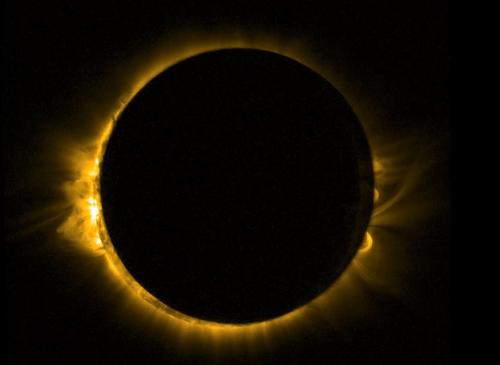
ESA's Proba-2 spacecraft captures the Moon passing in front of the Sun in 2015.
 |
CESAR organized a SPECIAL EVENT on the 21st August, 2017, for the TOTAL SOLAR ECLIPSE 2017. Students, teachers and general public were invited to join. Please contact us if you want to participate and/or organize any special connection for future events.
A CESAR Expedition travelled to USA to cover the event. NOTE that totality happened at 10:42 local time in Casper, Wyoming, USA, 19:42 in local time Europe CEST. The eclipse shadow took .5h to cross the continental USA from Oregon to South Carolina.
|
Questions and answers for eclipses can be found here.
Event agenda
The event consisted of:
-
Live public event from the CESAR facilities at ESA-ESAC. The Sun experts from Solar Orbiter, Proba-2 and CESAR staff organized an interactive broadcast of the event. The format was a Google hangout, similar to the Mercury Transit 2016.
-
Special live image transmission from USA, Wyoming/Nebraska. A team travelled to USA to retransmit live the astonomical event. We used special cameras and spectrographs for the eclipse, plus the usual set-up (halpha-visible) of our daily observations at Helios Observatory.
The full program ran for 3h 30min, from ~16:00 UTC until 19:30 UTC (18:00 - 21:30 Europe time), covering from start to end of the partial eclipse.
The most important moment of the eclipse was totality, lasting 2min 30sec, at around 17:42 UTC in Casper. At that moment viewers can look at the Sun naked eye, as the Moon fully blocks the Sun. The spectacular corona and chromosphere is then visible without any special equipment. During totality, live connection with USA observing team was established. The actual totality time varies by some seconds, depending on the location in the USA.
The eclipse path
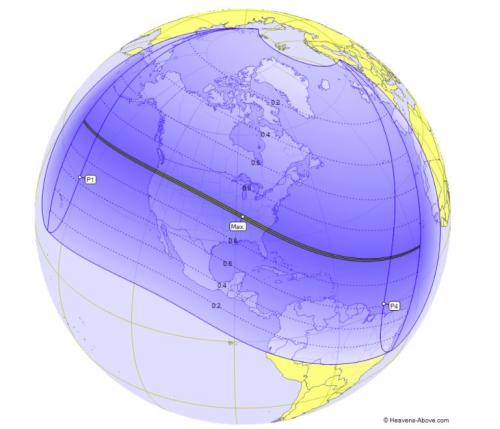 |
 |
|
World path. Courtesy of heavens-above.com
|
USA path. Courtesy of Xavier M. Jubier, please you can access his interactive web page. |
What to see
The Expedition captured several aspects of the eclipse
-
Fully capture the moon transit as image sequences from the start to end of the eclipse (~3h), including the totality (2min 30sec)
-
Totality: Baily beads (moon's valleys)
-
Totality: Diamond ring
-
Totality: Inner and outer corona images and video
-
Totality: Chromosphere (red)
-
Totality: Emission spectra of chromosphere and corona elements (H, Fe, Mg..)
-
Totality: polarization of corona
-
First person experience.
Expected products to be made public
Images were transmitted live when possible (bandwidth at USA was limited especially during totality, so there were some delays in the image transmission). Live connection with the Expedition team was established. The expected products are shown below, (images taken from other public eclipses/web, just for illustration). The actual deliveries were put together in this page. SOLAR ECLIPSE 2017 RESULTS. These might be different by various factors, due to the nature of an eclipse: weather, local network speed, unexpected surprises, equipment hiccups...
NOTE: ALL eclipse IMAGES BELOW ARE FROM OTHER SOURCES than the CESAR EXPEDITION USA 2017, they were posted before the event to illustrate the expected products, and therefore JUST FOR ILLUSTRATION. THe actual images during the expedition are located in the results web page.
|
Available LIVE (all eclipse from C1 to C4) |
 |
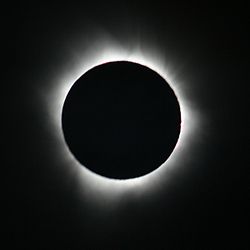 |
 |
|
Sun in H-alpha |
Sun in visible |
Live webcam still shots (one per minute or so) |
|
Available SOON AFTER the event (or whenever possible during event): |
 |
 |
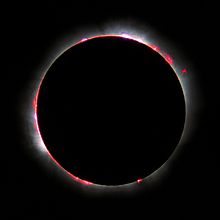 |
|
Baily's beads and diamond ring |
Sun espectra during totality (elements emission, H-alpha, He-D3, Mg, H-beta, FeX, FeXIV, HeI, H-gamma etc..) |
Chromosphere, telescope visible and 500mm camera |
 |
 |
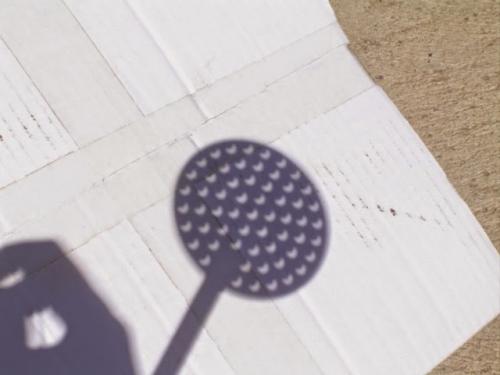 |
|
Inner Corona, 400mm and 500mm cameras, shorter exposure |
Outer corona, 300mm cameras, longer exposure |
Pinhole projection on the floor (we will create an ESA logo of mini-eclipsed Suns) |
|
Available AFTER THE EVENT (needs offline processing) |
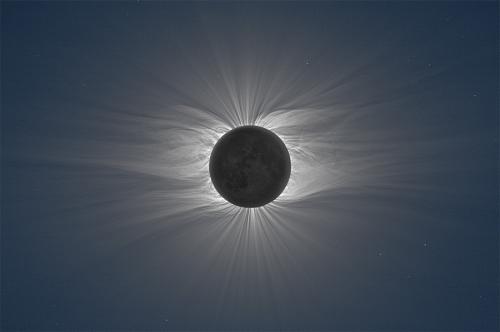 |
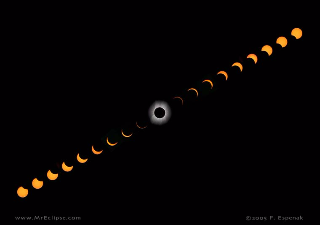 |
- H-alpha full eclipse (3h), all photos
- Visible, full eclipse (3h), all photos
- Corona, totality (2min), all photos
- Go-Pro videos (time-lapses of observing site)
- First person Go Pro of all the event |
|
HDR full corona composite, from 300,400,500 mm cameras at different exposures |
Landscape composite of full eclipse (wide angle, ~60 deg, 18mm camera) |
Videos |
Equipment
To achieve the goals above, the CESAR team transported some equipment to USA:
-
12 cameras to cover the event (8 DSLR, 3 go-pro, 1 webcam)
-
2 telescopes
-
4 tracking mounts
-
a couple of tripods
-
1 diffraction network
-
one polarizer
-
one pin-hole proyection
|
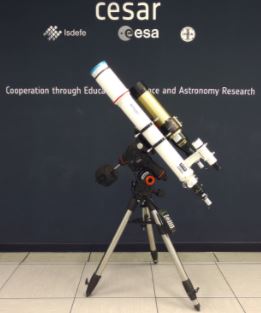 |
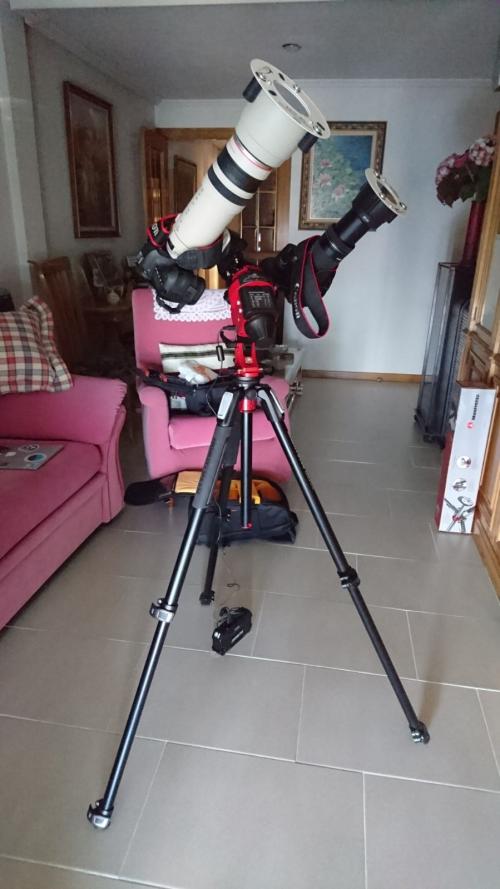 |
|
|
Telescopes halpha-visible on CGEM mount |
2 cameras (500mm, 400mm) on mount star adventurer |
The CESAR expedition: viewing locations in USA

Two locations have been pre-selected by the CESAR team. The final decision will be taken some days prior to the eclipse, when the local weather conditions are forecast at shorter term. Please note that the eclipse starts 7 min later in Alliance than in Casper.
NOTE: the LOCATION SELECTED was CASPER due to its better weather predictions than Alliance, and its higher altitude location.
-
Casper Mountain, Wyoming. 2 min 25 sec totality. At an altitude of 2400 meters, it reduces the atmospheric path for better image quality.
-
partial eclipse 16:22 UTC until 19:10 UTC, totality 17:42 UTC until 17:45 UTC
-

-
Alliance airport field, Nebraska. 2 min 30 sec totality. The weather conditions are the driest, in average, for the eclipse path in that time of the year.
-
partial eclipse 16:27 UTC until 19:16 UTC, totality 17:49 UTC until 17:51 UTC
-

-
Madrid, ESAC, will not see the totality, and in fact only some minutes of the partial eclipse, before Sunset.
-
17 min of partial eclipse, then Sun goes below horizon
-

CESAR expedition: top-level schedules leading to the eclipse day
-
Until 14 Aug: equipment preparation in ESAC, testing, and packaging for transport
-
14 Aug: weather check, t-1week, for a rough selection/check of the observation areas in the USA
-
18 Aug: full team in the USA, Wyoming (Joe Zender-ESTEC, Manuel Castillo-ESAC, Abel de Burgos-ESAC, Miguel Perez Ayucar-ESAC plus Dario Perez-external Silvia-external)
-
18 Aug evening. Weather check, t-3days, and decision on observation site (Casper-Wyoming, Alliance-Nebraska, or other)
-
19 Aug: driving to observation site. Local spot selection. At night first telescopes alignment
-
20 Aug: full rehearsal. Weather check, t-1day, final decision on location spot. At night, alignment telecopes.
-
21 Aug : early morning for us, afternoon/evening for Europe --> eclipse and hangout live in Spain
SOLAR ECLIPSE 2017 team
-
CESAR expedition @ USA: Miguel Perez Ayucar-ESAC, Abel de Burgos Sierra-ESAC, Manuel Castillo-ESAC, Joe Zender-ESTEC, Silvia García Soto-external, Dario Perez-external
-
CESAR team @ ESAC: Michel Breitfelner-ESAC, David Cabezas-ESAC, Santa Martinez-ESAC, Roberto Prieto-ESAC, Donald Merritt-ESAC
-
Communications and Education ESA: Emily Baldwin-ESTEC, Markus Bauer-ESTEC, Emmet Fletcher-ESAC
Mobile app for the eclipse
The Sun Now
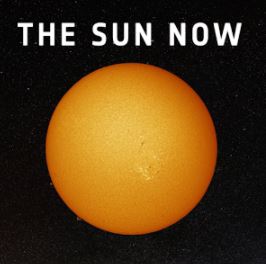
Past educational events by CESAR team
Mercury Transit 2016 - Chile - Spain
Venus Transit 2012 - Svalbard - Australia
|
|
|